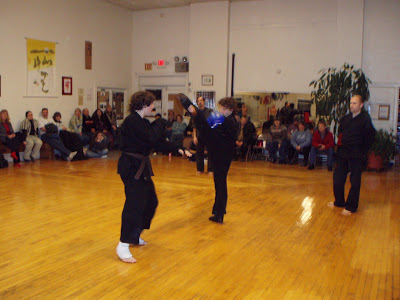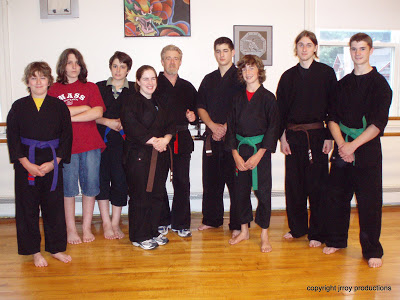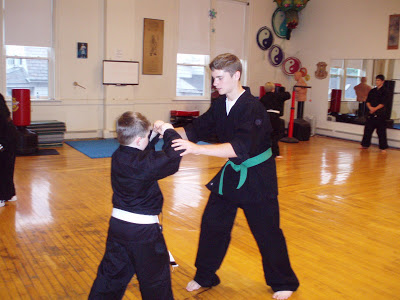 Students sparring at a recent Belt Testing. TP shows good kicking form during the match.
Students sparring at a recent Belt Testing. TP shows good kicking form during the match.
Tag: Amercian Karate-Do
Joint Locking, how to practice it safely and have it contribute to health maintainance
JRRMAS Staff member JK assists Sifu in an explanation of how to correctly practice Joint Lock’s.Lesson 1:These practices can injure your joints if not practiced properly, Always practice with respect for each others range of motion limitations. Injury is guaranteed if you practice to quickly and use too much external muscular force….Instead, concentrate on the exactness of your fulcrum and lever…. and proper body positioning, listening skills and leverage. Speed is good…..up until the point where the slack is taken out of their jointthen you must go slowly giving them time to ‘slap out’Going slowly at the point that the joint lock is ‘activated’ ……will gradually increase the strength and the range of movement in the jointThen instead of injuring the jointsthey are slowly being strengthened and stretched!Sifu
American Karate-Do, Black Belts Side Kicking practice
JRRMAS Staff members NL, JC and DG practice defensive (not stepping in) Side Kicks in a recent Adult American Karate-Do class. NL is leading the class. All are demonstrating excellent form.Lesson 1:Side Kicks are both a classical and a modern basic techniqueThe kick also crosses over to real life self-defensefrom both a standing and a lying position.It is one of the most powerful techniques in Martial Arts, especially for women. For men the legs are twice as powerful as their arms, but for women the legs are four times as powerful as their arms! So learning to kick is a must for women’s self-protection, especially the side kicking action that uses the joints of the hip and the knee working in unison. The Side Kick is a very powerful kick indeed!Lesson 2:Remember to drive your knee straight up (as in a front kick)and learn to use the momentum of the initial vertical action of the kneechanging it from vertical to horizontalThe ‘secret’ to a quick and powerful Side Kick is keeping the knee up as the initial power of the vertical knee driveturns the ‘corner’ to a horizontal thrusting action using the hip and the knee jointBe very clear about the ‘line of power’ at the end of your kick!!
American Karate-Do, Wallace Roundhouse Kick Exercise
JRRMAS Staff member DG demonstrates his excellent kicking form. This is an exercise I learned from Bill ‘Superfoot’ Wallace back in the 1980’s and has become an intergral part of the American Karate-Do curriculum for both the Youth and Adult groups. Lesson 1:Doing the kick slowly gives you the best indication of your kicking ability. Your knowledge of the kick will be revealed by going slowly. This knowledge includes:Kicking knee position, Supporting foot position, Hip position, Upper body position Slow kicking will also reveal :Your stretch, Your strength And most importantly your balance. Slow kicking is healthy for practitioners of all Martial Arts and for praticioners of all ages!Slow kicking is a tried and true method that has come down through the ages. Many thanks to Bill Wallace for pointing us in the correct direction!
Tuesday’s Youth Karate-Do Class
 A group photograph of the Youth Karate-Do class this past Tuesday. We did an ‘open workout’ where the students have to use their own initiative and creativity. This was an excellent group….hard working, productive and focused. They were inspiring each other, while researching and examining the ‘Art’…. What more could a Teacher look for?
A group photograph of the Youth Karate-Do class this past Tuesday. We did an ‘open workout’ where the students have to use their own initiative and creativity. This was an excellent group….hard working, productive and focused. They were inspiring each other, while researching and examining the ‘Art’…. What more could a Teacher look for?
A big congratulations to JS for his recent graduation from High School! All the best luck to you!!
American Karate-Do, Line Work “smoothing out the combination”
JRRMAS Staff member DG talks about smoothing out the combination. DG is the newest American Karate-Do Black Belt. He was promoted in January of this year and is doing an excellent job with the programs that he is helping with on Staff. He is currently involved with the Little Dragons, Youth Karate-Do and Adult Karate-Do programs. DG is often seen hosting free-sparring clinics/sessions after classes on Monday and Thursday evening. He is having very positive effect overall on the three Karate programs at the Studio.Coming up shortly, I’ll be posting a video clip of DG practicing/demonstrating the ‘Wallace’ slow Roundhouse Kick exercise….stay tuned as his skill and ability in kicking is truly remarkable!Lesson 1:When the Cross (rear hand) retracts, it’s like pulling on a lever that drives the rear knee up for the Front Kick. In a combination the moment the first technique starts to retract the next one starts it’s journey to the target and as that new one starts retracting, it set’s the next technique into motion and so on…… Smoothing out the relationship between the techniques in the combination. Feints and fakes and minor timing changes (broken motion) can also be added to the combination to increase the chances of creating an opening that you can take advantage of.
American Karate-Do, Seiuchin Kata, students practicing
Black Belt Candidate JS leads the Saturday Karate-Do class through Seiuchin Kata, the third Kata in the American Karate-Do System. This Kata teaches 45 degree angles, multiple strikes with the same hand and stepping forward and backward in a straight line.
Students helping each other

A photo of student helper SM adjusting the position of a junior student in a recent youth American Karate-Do class.
American Karate-Do, Crescent step, block and punch drill
JRRMAS Staff member JK leads the adult Karate-Do group in classical basics (retracting hand going to the hip for the rear elbow strike) Lesson:Crescent step…feet come close togetherto protect the groinwhile advancing forwardat the moment the rear footshuffles to the new Seisan Stance Focus your Reverse Punch (classical vertical punch from the rear side)or focus your blockThen Reverse PunchAt either end of the Studio Triangle Stepto turn around with power.This drill builds dynamic root and stability, coordination and basic mind/body connections needed for Martial Arts and overall neurological conditioning. Rows of basic stepping, blocking, puching/kicking and turning are an intergral part of many Styles of Martial Arts…..it’s the foundation of the Kata’s and the basis for more advanced practices.Sifu
Modern Arnis, students practicing joint locks
Students SMc and SM practice a joint lock series in an American Karate-Do class recently
